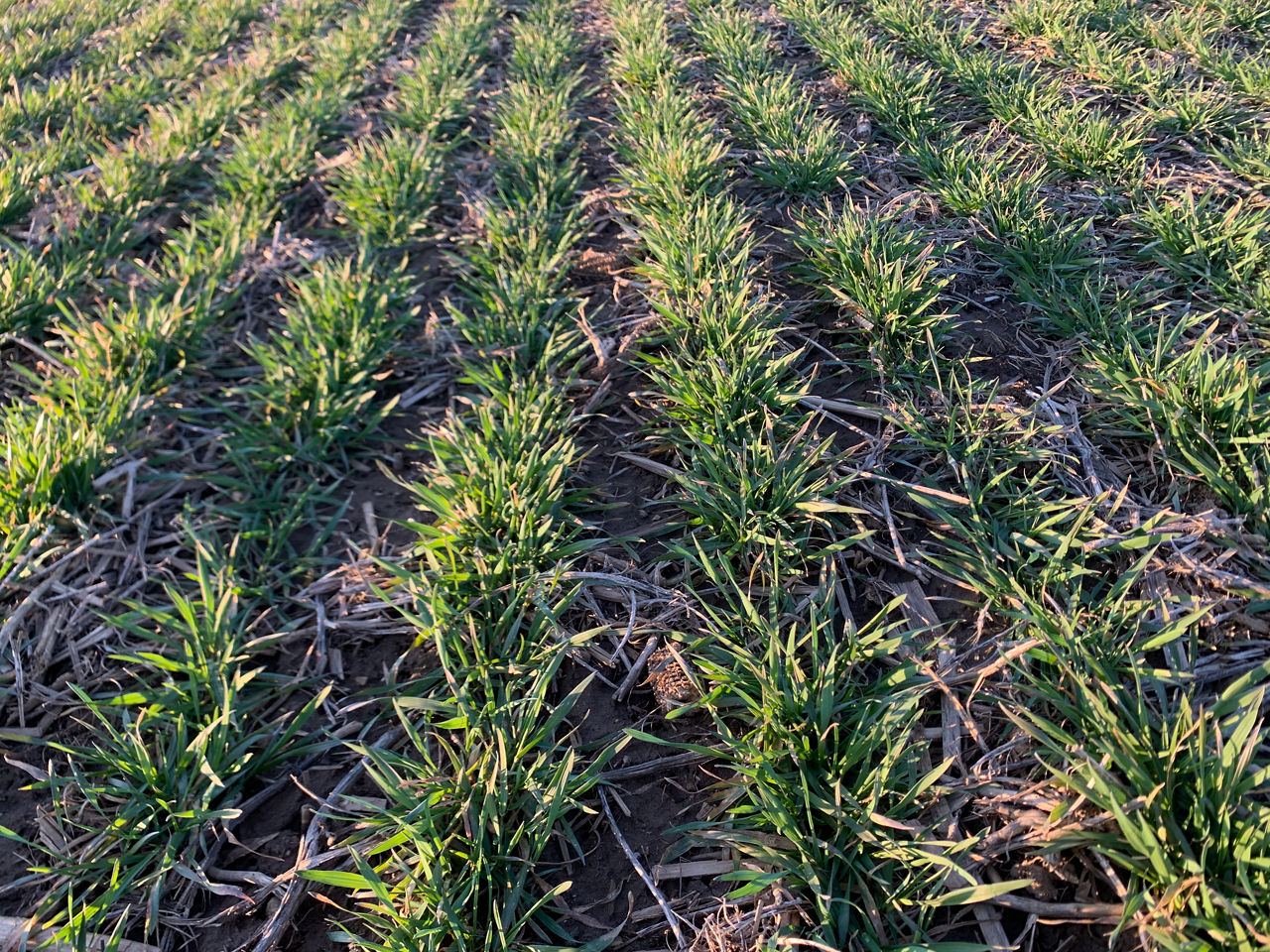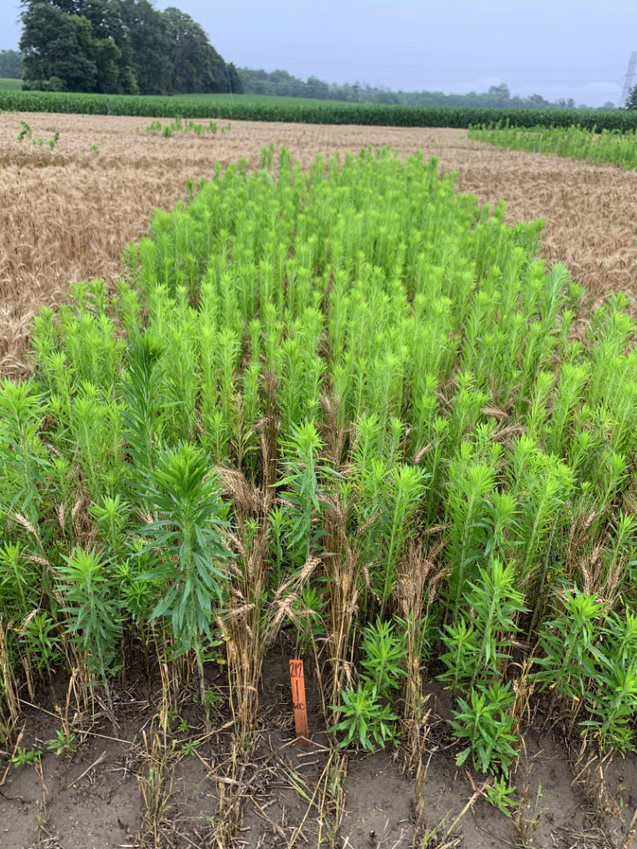3 READ-TIME
Winter Wheat Weed Control After Soybeans
January 20, 2022
Objectives of Weed Control in Winter Wheat
Winter wheat weed management can be complicated considering problem weeds for soybeans can carry into fall and spring growing seasons. Consider plant-back restrictions to avoid herbicide carryover issues. After soybean harvest, work to establish dense, vigorously growing stands of winter wheat. Additionally, scouting and herbicide applications begin in the fall.
The critical period of weed control is from early emergence through booting or between 500 and 1,000 growing degree days for winter wheat.1,2 Weeds should be controlled during this period to avoid loss of yield potential. This critical period of weed control occurs early and is shorter if fall-time temperatures are warm.

Figure 1. This winter wheat is establishing strong because weed control started in the fall.
Management of weeds should continue in the spring as a weed seed count reported the potential to disperse 50 million weed seeds after harvest.1 Winter wheat regrowth, and the start of reproductive growth stages depends on spring temperatures and moisture. Outlined below are the germination patterns of problem weeds, timing of weed control, management options, and effect on winter wheat yield.
Growth and Germination of Problem Weeds
Winter annual weed growth begins over a range of cooler temperatures. Ideal germination occurs when soil temperatures are between 12 to 20°C for chickweed and 14 to 15°C for Canada fleabane.3,4 Chickweed seed is viable as soon as shed, and most Canada fleabane seed germinates from August to November. Annual bluegrass, a relatively new weed issue, germinates as soil temperatures drop below 21°C.5 When scouting weeds, note the density, growth stage, and susceptibility to herbicides. Herbicides are most effective on actively growing weeds, and application timing should avoid wide fluctuations in temperature, frost events, and temperatures below 10°C.6

Figure 2. Chickweed emerges early in the fall, before winter wheat canopy development. Effective weed control targets small weeds when they are easier to kill.
Timing of Weed Control
- Preplant. Weed control should start with a clean, weed-free seedbed for winter wheat seeding. Preplant applications often include glyphosate for broad-spectrum control of winter annual, biennial, and perennial weeds before seeding operations.
- Fall POST. Wheat seedlings should not compete with weeds as they emerge in the fall. Early weed competition can inhibit tillering and yield potential for next summer. Winter annual and perennial weed regrowth may be subtle in the fall, but if left uncontrolled, these weeds become difficult to control in the spring.
- Spring. Wheat reproductive stages begin in the spring. The narrow application window of 2,4-D and MCPA make them a challenge to apply in the spring between tillering and jointing.7 Always follow label directions as each herbicide has a maximum wheat growth stage for application.
See Table 1 for herbicide recommendations, timing, and wheat stages. General recommendations below:
| Chickweed (Stellaria media) | Preplant | Glyphosate | Preemerge |
| Fall POST | Refine® SG herbicide (when chickweed has 1 to 6 leaves) | From 2-leaf to flag leaf, prior to head emergence | |
| Spring | Trophy® or | 3-tiller stage until prior to flag leaf | |
| Infinity® herbicides | Apply prior to flag leaf emergence | ||
| Canada fleabane (Conyza canadensis) | Preplant | Eragon® LQ + Glyphosate + Merge (surfactant) Dicamba | Preemerge |
| MCPA | |||
| Fall POST | Barricade® M Enforcer® M Infinity® herbicides Lontrel® XC Pyralid Pixxaro® Trophy® |
||
| Spring | MCPA Infinity® herbicides |
Until early flag leaf stage | |
| Annual bluegrass (Poa annua) | Preplant | Fierce® EZ | At least 7 days PP to wheat planted at least 2.5 cm deep |
| Focus® | PP and PRE to wheat planted at least 2.5 cm deep | ||
| Fall POST | Simplicity™ GoDRI™ | From 3-leaf stage before flag leaf emergence | |
| Spring | Simplicity™ GoDRI™ | From 3-leaf stage before flag leaf emergence | |
Sources: Sikkema, P.H. 2015. Weed management in winter wheat. University of Guelph - Ridgetown Campus. https://www.yumpu.com/en/document/view/32371640/weed-management-in-winter-wheat-ridgetown-campus- Ontario Ministry of Agriculture, Food, and Rural Affairs. 2021. Cereal crops. Guide to Weed Control. Chapter 7. Pub 75. |
|||
Cultural Practices for Weed Control
Planting date for winter wheat is dictated by soybean harvest. Time is short for spray operations; however, many winter annual species germinate during this time. Tillage may not be practical with scarce moisture or approaching frost but seeding rate and wheat variety can be adjusted to achieve a dense, healthy stand. Earlier seeding dates, with early soybean harvest, means winter wheat can reach canopy and seeding rate can be reduced.
Effect on Winter Wheat Yield
Herbicides applied late, outside the growth stage recommendations, can result in kernel abortion and blank wheat heads. Ultimately, this excessive injury can reduce yield. Crop injury does not always cause yield loss, but weeds allowed to compete have been reported as causing over a 10 percent yield loss in winter wheat.1 Put effort into establishing a strong and healthy winter wheat stand, scout early, and prepare for herbicide applications to keep yield potential goals.

Figure 3. Canada fleabane bolts in the spring, quickly becoming a competitor with winter wheat as it enters reproductive stages. Fewer herbicide options exist for spring-control of Canada fleabane.
Sources
1 Ontario Ministry of Agriculture, Food, and Rural Affairs. Pub 811. Chapter 13. Weed Control.
2 United States Department of Agriculture. Metadata for winter/spring wheat growth stage models. International Production Assessment. Division. https://ipad.fas.usda.gov/cropexplorer/description.aspx?legendid=313®ionid=na
3 Ag-info Centre. 2011. Chickweed, common. Pest Selector. http://www.agric.gov.ab.ca/app107/printerfriendly?id=117
4 2017. Canada fleabane Conyza canadensis L. http://fieldcropnews.com/wp-content/uploads/2017/05/ERICA_PWB_2017.pdf
5 LeStrange, M., Geisel, P.M., Cudney, D.W., Elmore, C.L., and Gibeault, V.A. 2012. Annual bluegrass. Pests in Gardens and Landscapes. University of California. http://ipm.ucanr.edu/PMG/PESTNOTES/pn7464.html
6 Sprague, C. 2020. Weed control in winter wheat: what do I need to consider? Michigan State University. https://www.canr.msu.edu/news/herbicide_options_for_weed_control_in_winter_wheat_things_to_consider.
7 Sikkema, P.H. 2015. Weed management in winter wheat. University of Guelph - Ridgetown Campus. https://www.yumpu.com/en/document/view/32371640/weed-management-in-winter-wheat-ridgetown-campus-.
Legal Statements
ALWAYS READ AND FOLLOW PESTICIDE LABEL DIRECTIONS. Performance may vary from location to location and from year to year, as local growing, soil and weather conditions may vary. Growers should evaluate data from multiple locations and years whenever possible and should consider the impacts of these conditions on the grower’s fields.
Tank mixtures: The applicable labeling for each product must be in the possession of the user at the time of application. Follow applicable use instructions, including application rates, precautions and restrictions of each product used in the tank mixture. Bayer has not tested all tank mix product formulations for compatibility or performance other than specifically listed by brand name. Always predetermine the compatibility of tank mixtures by mixing small proportional quantities in advance. Bayer, Bayer Cross and Infinity® are registered trademarks of Bayer Group. Used under license. All other trademarks are the property of their respective owners. Bayer CropScience Inc. is a member of CropLife Canada. ©2021 Bayer Group. All rights reserved. 8011_S1_CA
